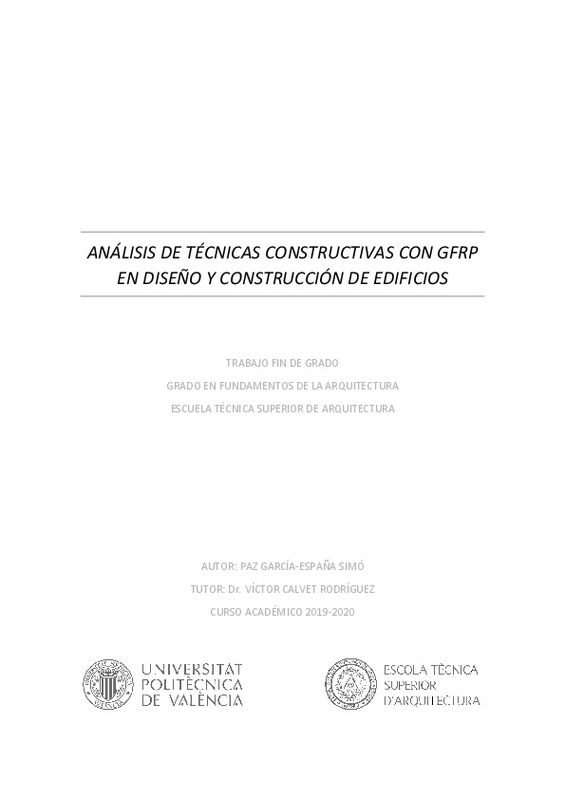JavaScript is disabled for your browser. Some features of this site may not work without it.
Buscar en RiuNet
Listar
Mi cuenta
Estadísticas
Ayuda RiuNet
Admin. UPV
Análisis de técnicas constructivas con GFRP en diseño y construcción de edificios.
Mostrar el registro sencillo del ítem
Ficheros en el ítem
| dc.contributor.advisor | Calvet Rodríguez, Víctor
|
es_ES |
| dc.contributor.author | García-España Simó, Paz
|
es_ES |
| dc.date.accessioned | 2022-03-14T11:01:30Z | |
| dc.date.available | 2022-03-14T11:01:30Z | |
| dc.date.created | 2020-09-17 | |
| dc.date.issued | 2022-03-14 | es_ES |
| dc.identifier.uri | http://hdl.handle.net/10251/181429 | |
| dc.description.abstract | [ES] Durante estas últimas décadas, debido al considerable problema que presentan las estructuras de hormigón armado frente al efecto de la corrosión y el gran coste de las reparaciones por este motivo, se ha incrementado la demanda del uso de otros materiales para la armadura de los sistemas estructurales, por lo que se han realizado investigaciones sobre el uso de materiales innovadores que puedan sustituir a las barras de acero y que puedan cumplir con todas las necesidades que requieren estas estructuras durante su vida útil. El presente Trabajo de Fin de Grado se fundamenta en el estudio de las diferentes técnicas de construcción de las estructuras mediante el uso de las barras de polímero reforzado con fibra de vidrio GFRP (Glass-Fiber Reinforced Polymer), un desarrollo importante en la tecnología del hormigón reforzado. Para ello se van a analizar diferentes estructuras realizadas con este tipo de armado, y se realiza una comparación frente a la construcción tradicional mediante hormigón armado con redondos de acero corrugado. Al mismo tiempo, se analiza el distinto diseño en proyecto y en el proceso de ejecución que tiene implícito este tipo de solución constructiva con GFRP. Por último se analiza el coste de estas soluciones constructivas y se compara con las soluciones tradicionales. Tras el análisis de los datos obtenidos en este trabajo, se obtiene que el uso de las barras de polímero reforzado con fibra de vidrio, es solución alternativa para el reemplazo de las barras de acero en las estructuras, ya que este tipo de barras pueden soportar mayores cargas, debido a que la resistencia a tracción es superior que las barras de acero, sumado a la ventaja de que es un material no corrosivo, por lo que las estructuras ya no tienen la necesidad de futuras reparaciones y garantizan una mayor durabilidad. Por todo esto, este material podría sustituir el uso del acero en los sistemas estructurales de hormigón armado e incluso optimizar el comportamiento de la estructura. | es_ES |
| dc.description.abstract | [EN] During these last decades, due to the considerable problem presented by reinforced concrete structures against the effect of corrosion and the great cost of repairs for this reason, the demand for the use of other materials for the reinforcement of structural systems has increased. Therefore, research has been carried out on the use of innovative materials that can replace steel bars and that can meet all the needs required by these structures during their useful life. This End of Degree Project is based on the study of the different construction techniques of the structures through the use of GFRP (Glass-Fiber Reinforced Polymer) bars, an important development in reinforced concrete technology. To do this, different structures made with this type of reinforcement will be analyzed, and a comparison will be made with traditional construction using reinforced concrete with corrugated steel rounds. At the same time, the different design in the project and in the execution process implied by this type of construction solution with GFRP is analyzed. Finally, the cost of these construction solutions is analyzed and compared with traditional solutions. After the analysis of the data obtained in this work, it is obtained that the use of the glass fiber reinforced polymer bars is an alternative solution for the replacement of the steel bars in the structures, since this type of bars can support higher loads, due to the fact that the tensile strength is higher than the steel bars, added to the advantage that it is a non corrosive material, so the structures no longer have the need of future repairs and guarantee a higher durability. For all this, this material could replace the use of steel in reinforced concrete structural systems and even optimize the behaviour of the structure. | es_ES |
| dc.format.extent | 74 | es_ES |
| dc.language | Español | es_ES |
| dc.publisher | Universitat Politècnica de València | es_ES |
| dc.rights | Reserva de todos los derechos | es_ES |
| dc.subject | GFRP | es_ES |
| dc.subject | FRP | es_ES |
| dc.subject | Barras corrugadas de fibra de vidrio | es_ES |
| dc.subject | Hormigón | es_ES |
| dc.subject | Barras corrugadas de acero | es_ES |
| dc.subject | Corrugated fiberglass bars | es_ES |
| dc.subject | Concrete | es_ES |
| dc.subject | Corrugated Steel bars | es_ES |
| dc.subject | Barras reforzadas con fibras | es_ES |
| dc.subject | Fiber-reinforced bars | es_ES |
| dc.subject.classification | CONSTRUCCIONES ARQUITECTONICAS | es_ES |
| dc.subject.other | Grado en Fundamentos de la Arquitectura-Grau en Fonaments de l'Arquitectura | es_ES |
| dc.title | Análisis de técnicas constructivas con GFRP en diseño y construcción de edificios. | es_ES |
| dc.type | Proyecto/Trabajo fin de carrera/grado | es_ES |
| dc.rights.accessRights | Abierto | es_ES |
| dc.description.bibliographicCitation | García-España Simó, P. (2020). Análisis de técnicas constructivas con GFRP en diseño y construcción de edificios. Universitat Politècnica de València. http://hdl.handle.net/10251/181429 | es_ES |
| dc.description.accrualMethod | TFGM | es_ES |
| dc.relation.pasarela | TFGM\122108 | es_ES |
Este ítem aparece en la(s) siguiente(s) colección(ones)
-
ETSA - Trabajos académicos [4459]
Escuela Técnica Superior de Arquitectura






